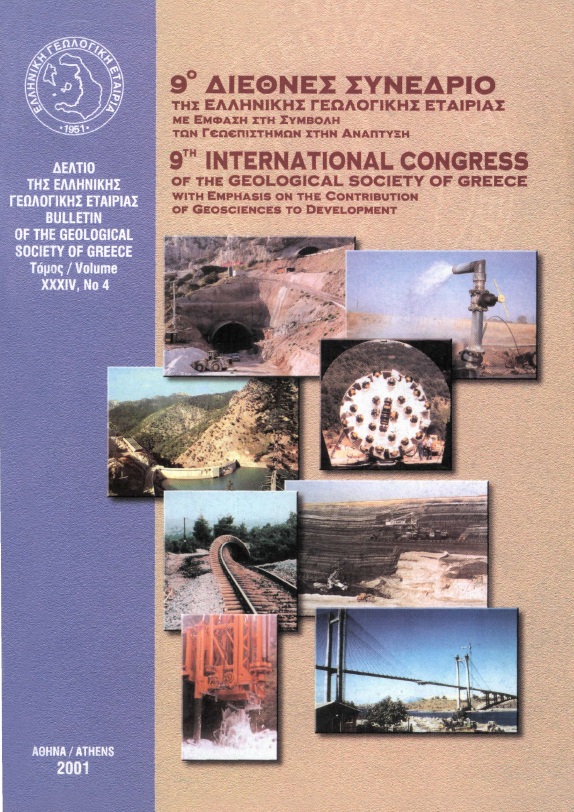SEISIMPACT-THES: A SCENARIO EARTHQUAKE AFFECTING THE BUILT ENVIRONMENT OF THE PREFECTURE OF THESSALONIKI
Περίληψη
In the framework of the "SEISIMPACT-THES" project (Koutoupes et al., 2004; Savvaidis et al., 2004) a GIS database has been designed to include information on a wide range of components related to seismic risk within the broader area of the prefecture of Thessaloniki. One of these components refers to the distribution of strong ground motion produced by large earthquakes and the ability of a potential future user of the database to retrieve information regarding the distribution of strong ground motion from past destructive earthquakes in the area of Thessaloniki, as well as relative information for realistic future scenario earthquakes in the same area. The selection of future scenario earthquakes that may affect this urban region of interest is based on a combined review of historical data, previous probabilistic and deterministic hazard assessments, seismotectonic and microseismicity studies, relocated seismicity in northern Greece and the experience gained from worldwide research. In this study we present the results from hypothetical rupture of one fault that is located at the suburbs of the city, the Asvestochori fault. Empirical relations applicable to Greece (Papazachos & Papazachou 2003), as well as seismicity information are combined to determine the dimensions of the scenario earthquake source. Strong ground motion for the selected scenario is simulated using the stochastic method for finite faults (Beresnev and Atkinson, 1997). Uncertainties due to unknown parameters such as the rupture initiation point and the distribution of slip on the fault plane are taken into account by examining a large number of random scenarios. The average values from these multiple scenarios are then used to compile maps of strong ground motion parameters (e.g. peak ground acceleration and spectral acceleration). Although the examined scenario earthquake is moderate in size (Mw 5.2), the level of the resulting strong ground motion parameters is indicative of the potential destructiveness of the examined source. Due to the simplicity in the underlying assumptions of the stochastic method, the results of this study are a first-order approximation to the problem of defining expected shaking in the wider area of Thessaloniki. Other strong motion simulation methods of more deterministic character will also be applied for the same purpose in the framework of the SEISIMPACT-THES project.
Λεπτομέρειες άρθρου
- Πώς να δημιουργήσετε Αναφορές
-
Kiratzi, A., Roumelioti, Z., Benetatos, C., Theodulidis, N., Savvaidis, A., Panou, A., Tziavos, I. N., Savvaidis, P., Hatzigogos, T., Koutoupes, S., & Karantonis, G. (2004). SEISIMPACT-THES: A SCENARIO EARTHQUAKE AFFECTING THE BUILT ENVIRONMENT OF THE PREFECTURE OF THESSALONIKI. Δελτίο της Ελληνικής Γεωλογικής Εταιρείας, 36(3), 1412–1421. https://doi.org/10.12681/bgsg.16529
- Ενότητα
- Σεισμολογία

Αυτή η εργασία είναι αδειοδοτημένη υπό το CC Αναφορά Δημιουργού – Μη Εμπορική Χρήση 4.0.
Οι συγγραφείς θα πρέπει να είναι σύμφωνοι με τα παρακάτω: Οι συγγραφείς των άρθρων που δημοσιεύονται στο περιοδικό διατηρούν τα δικαιώματα πνευματικής ιδιοκτησίας επί των άρθρων τους, δίνοντας στο περιοδικό το δικαίωμα της πρώτης δημοσίευσης. Άρθρα που δημοσιεύονται στο περιοδικό διατίθενται με άδεια Creative Commons 4.0 Non Commercial και σύμφωνα με την οποία μπορούν να χρησιμοποιούνται ελεύθερα, με αναφορά στο/στη συγγραφέα και στην πρώτη δημοσίευση για μη κερδοσκοπικούς σκοπούς. Οι συγγραφείς μπορούν να: Μοιραστούν — αντιγράψουν και αναδιανέμουν το υλικό με κάθε μέσο και τρόπο, Προσαρμόσουν — αναμείξουν, τροποποιήσουν και δημιουργήσουν πάνω στο υλικό.








